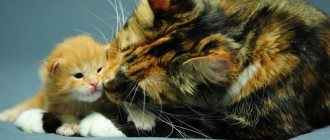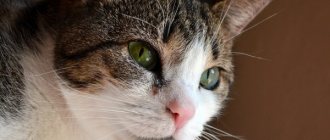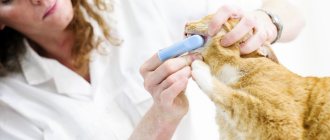Typically, the need to determine the age of a kitten arises if it is thrown or given as a gift. If with a “gift” things are much simpler, you can ask and get information from those who gave the gift, then with a foundling (or picked up on the street) everything is much more complicated. There is also no question if this baby is from the lambing of your own cat. A dropped or picked up kitten needs certain care, vaccination and feeding. Here, not only months, but even days are of great importance, because nutrition will have to be selected according to his age. How to determine the age of a kitten? There are a number of ways, which are described below.
By the eyes
Determining age by the eyes is relevant for small kittens; it is not possible to apply this method to adult pets due to the peculiarities of biological development.
How to determine the age of a cat from the first days of life is important for maintaining the diet of newborn animals that find themselves, for example, without a mother. Newborn kitten
On the first day, newborn kittens are blind. At about 7 to 10 days of age, the eyes begin to open. Already open, but narrowed eyes indicate that the babies are 2-3 weeks old. By 3-4 weeks of age, kittens’ eyes are already fully open.
The color of the eyes can tell how old a kitten is. As a rule, instability of iris coloration is observed at the age of 6 - 7 weeks.
2-3 months
At the age of 2-3 months, you can only focus on the size of the kitten and its behavior. By 3 months, the ears are noticeably enlarged. The veterinarian also evaluates the development of baby teeth.
During the period of 2-3 months, it is recommended to do a double vaccination against viral diseases of cats.
At 3 months the pet knows where the tray and bowl are and comes when called. Weight is about 1-1.3 kg. The first rabies vaccination is allowed from 3 months of age. Domestic kittens are most often taken to a new home at this age.
How to find out the age of a kitten by external signs
Every owner should know how old his pet is. It's easy to see the difference in what a 1 month or 1 week kitten looks like in appearance. It develops at a rapid pace, at each specific stage there are characteristic signs that indicate an approximate date (only a veterinarian can say for sure).
- size;
- weight;
- teeth;
- eye color;
- appearance;
- behavior.
Newborn kittens have obvious external signs. They are born blind, cannot walk, have a disproportionately large head, short ears tightly pressed to it, and no teeth at all. Some people have dried remains of the umbilical cord on their tummy. The rapid growth of kittens leads to changes in their physical characteristics, but some parameters have a clear gradation according to age.
By weight
Determining the age of a kitten by weight is considered very approximate. This is due not only to the physiological characteristics of some breeds, but also to individual genetic inclinations. However, it is known that feeding a kitten well will add approximately one hundred grams of weight per week.
The initial weight of a newborn pet averages from ninety to one hundred and twenty grams. A weekly weight gain of one hundred grams implies that a three-week-old kitten can weigh about three hundred grams. But it is worth considering one more pattern. Weight gain decreases as the kitten ages. Therefore, normally a five-week-old pet can weigh no more than half a kilogram.
To size
Calculating age based on the size of a kitten is similar to the principles of calculating based on its weight. As your pet grows, fewer and fewer centimeters are added to its size every week. In this case, it is worth taking into account hereditary factors, as well as the gender of the pet. On average, a newborn kitten reaches ten centimeters. The measurements do not take into account the dimensions of the tail.
Every month, a kitten can increase in size on average from three to five centimeters and already reach twenty-five centimeters at the age of six months. It should be noted that males gain two centimeters more in size than females. This is why kittens of the same litter can differ significantly from each other in size.
Tough
Small pets usually have their first teeth at the end of the third week of life. Over the course of eight weeks, a certain number should increase. To understand how many teeth correspond to a particular age of a kitten, you need to know the chronology of their appearance. At three to four weeks the kitten has primary incisors.
At six weeks, small molars grow on the sides of the jaw. By eight weeks, the baby already has fangs. Starting from approximately the fourteenth week, baby teeth are replaced by permanent incisors, and this process continues up to six months. By this age, there are twenty-six teeth in the pet’s mouth. But animals whose age has exceeded six months have four more molars (molars).
By the eyes
In order to calculate the age of a kitten by its eyes, you need to know that all newborns have the same gray-blue color. Kittens are born blind; their eyes begin to open on the tenth or twelfth day of life. The natural color of the iris is formed by three months. However, there are a dozen cat breeds that have naturally blue eyes. These include: Angora, Polynesian, Canadian Sphynx, Thai, Siamese, British.
We suggest you familiarize yourself with: Designation of the tail in cats. How to determine cat behavior by their tail
As kittens age, their behavior also changes. If you pay attention to certain nuances, you can with a high degree of probability determine the age of the pet. So, literally up to two weeks, the kitten is still practically crawling on its tummy, occasionally trying to rise on its fragile paws. By one month he is moving more confidently, trying to jump and run.
By the eighth week, kittens spend most of their time playing. They overcome heights with ease, and are always in search of new entertainment. It is important that by the external signs and behavior of a kitten that was picked up on the street, it is not always possible to reliably determine its age. After all, the development of an animal is also influenced by its state of health.
Minimum and maximum
Surely your cat periodically gives birth to 4 to 6 kittens - this is the average for representatives of all breeds. There are also cases of the birth of 8 or more cubs. The fact is that a furry mother has a certain limit - a certain number of babies that she can feed. Their number should not exceed the number of her nipples. If there are more than eight kittens, one will not get milk, which means the baby may die. Then the owners will have to help the young mother feed her offspring.
The minimum number of kittens is one; there are cats that, due to genetic and physiological characteristics, are not able to conceive and bear a large number of fetuses. If your cat usually gives birth to around five babies and suddenly gives birth to one, you should take her to the vet - there is most likely something wrong with her health.
How many kittens can a cat give birth to maximum? It’s hard to say, the known documented limit is 15 pieces. But in general, the number of kittens over 10 is already rare. In purebred animals, the threshold is even lower - they rarely reproduce more than 6 kittens.
An older mother will no longer give birth to the same large litter as in her best years. The reproductive system wears out over time, and the likelihood of a difficult pregnancy increases. It is better to protect your cat from mating after reaching 8-10 years of age.
According to the condition of the coat and skeleton
Many owners are interested in how to find out the age of a cat by the condition of its coat and general appearance. To determine whether an animal is taken into the house old or young, it is enough to pay attention to the coat. Small kittens and young pets up to one year old have very soft and fluffy fur.
When assessing the condition of the coat of a young animal, owners note the presence of a thick and shiny coat. Each fiber has a clear color, which as a whole results in a clearly visible pattern. There are no gray hairs.
Cats older than 5 - 6 years old have a duller coat, and the outlines of the color pattern are not so clear. The cat's coat itself is not as thick and soft to the touch as that of a young animal. With age, the coat becomes denser and smoother. After 6-7 years, when examining individual hairs, gray hair can be detected.
In addition to changes in coat, as an animal ages, the musculoskeletal system also ages. As a rule, until six or seven years of age, and in some active pets even up to ten years of age, no obvious signs of skeletal changes are observed.
Owners often want to know how to find out the age of a cat based on the state of the musculoskeletal system. Young kittens are characterized by uneven body development. The juvenile appearance of the animal usually boils down to excessively long limbs, large ears, and incorrect proportions, which give a lanky and awkward appearance.
With age, the animal acquires strong muscles, becomes proportional and meets the criteria of a particular breed. In young people, muscle relief is observed. The pet's movements are filled with strength and grace. The gait is light and relaxed. The young cat easily overcomes obstacles and makes graceful jumps.
After 7–8 years, the cat’s skeleton begins to undergo changes. Older pets experience sagging of the spine and protruding shoulder blades. The gait becomes not as easy as at a young age. The muscles become flabby and their volume decreases. Old animals are often thin.
Of course, it is impossible to determine the exact age of a pet based on criteria such as the condition of the coat and skeleton. But you can tell for sure whether the animal is young or old.
How to behave as an owner
Mating is a natural step for a current female, but it is not always possible. It's a bad idea to breed a female cat during her first heat. Simple methods and techniques will help ease the baby’s suffering:
- distract with favorite or new toys;
- pick up, stroke, massage, soothe with gentle words;
- feed frequently in smaller portions;
- reduce room lighting;
- use sedatives recommended by your veterinarian;
- invite an active neutered male for mating.
Some owners independently stimulate the cat to help the pet get through a difficult period if the cat does not want the cat or is unavailable. First you need to put a glove on your hand and prepare a clean cotton swab. You need to stroke the cat, which is in a state of rutting, on the back, and gently grab it by the withers.
The vulva is then gently stroked until the vagina begins to pulsate and the tail is pulled to the side. Now you can slowly insert a cotton swab or other suitable object inside
Stimulation is carried out until discharge occurs. The procedure is repeated several times.
If there are cats in the house, and mating is not planned, the current female must be isolated and harmless folk remedies used to calm her down. The bed should be placed next to a radiator or other heat source, and a warm heating pad should be placed. Frequent bathing helps relieve tension
You need to wash your pet carefully. If Murka doesn’t like water, the irritation will not subside, but will intensify.
Sometimes catnip or decoctions of soothing herbs: lemon balm, chamomile give results.
There are herbal soothing drops and tablets to stop Murka from screaming:
- Stop Stress;
- Cat Baiyun;
- Anti-stress.
They have a mild effect and do not affect the hormonal state of the animal. There are relatively safe means in the first aid kit to calm Murka down. Suprastin is given at the rate of a quarter of a tablet per five kilograms of weight, once a day towards night, for three days.
Suprastin suppresses the psyche of fluffies; it cannot be considered as a replacement for hormonal therapy or sterilization. The medicine is prescribed as a temporary measure after childbirth to delay the onset of a new pregnancy.
On specialized forums there are reviews, photos, prices for medicines, recommendations on what else can be used for a pet during estrus. If she starts peeing anywhere, marking her territory, she needs to use special underpants.
How kittens grow
The surest way to determine the age of a kitten is by observing it. There are certain periods of development of an organism that indicate the date of its birth. The older the pet, the more difficult it is to know exactly how old he is. The easiest way to do this is before 1 month, when the main stages of the formation of all animal body systems occur:
- the umbilical cord disappears;
- the baby begins to stand on his feet;
- body weight increases;
- eyes open, their color changes;
- teeth appear and grow.
We suggest you read: How long does pregnancy in cats last and how does it go?
False pregnancy
There are cases when all the signs of pregnancy are present (changes in appetite, swollen nipples, rounding of the abdomen), but the process of delivery does not occur. This happens during a false pregnancy.
The cat actively begins to arrange the nest and changes in behavior. A clear sign of a false pregnancy is the cat’s special attitude towards socks, gloves, and slippers. She carries these things as if they were her cubs, and even lies down to feed them.
You should not assume that this is all a game; in fact, an imaginary pregnancy is a severe hormonal imbalance in the body. It can appear in both mated cats and virgins. Siamese and Persian breeds are most prone to this condition.
For treatment, the veterinarian prescribes medications in combination with a low-calorie diet. It cannot be left to chance; it must be treated. Otherwise, a false pregnancy can lead to irreversible consequences:
- the development of mastopathy and, as a consequence, the formation of a malignant tumor;
- psychological changes (changes in the behavior and character of the animal).
Determining the age of the kitten
How to determine a cat's age by weight is not difficult for an inquisitive owner.
- at birth, the baby weighs about 85 - 100 grams;
- at the age of 7 days, the weight of the cub averages 160 - 170 grams;
- with a kitten weighing 200 grams, we can confidently say that he is 2 weeks old;
- at the age of one month, the kitten’s weight ranges from 290 to 380 grams;
- by the 2nd month the baby can reach 1 kg;
- a weight of 1.5 kg is recorded in 3-month-old kittens;
- at 4 months the kitten must weigh at least 2 kg;
- if the scale arrow shows 2 - 3 kg, then the age of the young animal is 5 months;
- a six-month-old kitten weighs about 3 kg.
Of course, the baby’s weight largely depends on the breed, the quality of food and the living conditions of the animal. Nevertheless, this method can be used when determining the age of a young pet.
By weight
Determining the age of a kitten by weight is quite easy:
- a baby who is not even a week old weighs no more than 115 grams;
- at the age of 1-2 weeks, weight fluctuates between 170 grams;
- at the beginning of the 3rd week from birth, the baby will weigh up to 220 grams;
- the weight of a normal pet at 3 weeks of age usually reaches up to 280 grams;
- at 4-5 weeks the average kitten weighs 230-450;
- if the pet is already about 2 months old, then its weight is from 680 grams. up to 0.9 kg.
Kittens whose weight has exceeded 1.5-2 kilograms are usually called juniors, that is, those who have reached 7 months of age.
Tough
To understand how many days or months a kitten can handle, take the baby in your arms and gently spread its jaw. Now count how many baby and molar teeth he has on the bottom and top. Now compare the result with the options below:
- The kitten’s incisors (deciduous) are cutting, which means he is from 2 to 5 weeks old;
- the change of teeth to molars takes place at the stage of 3-5 weeks of his life;
- fangs (milk) are cut in pets who are from 3 to 8 weeks old;
- Permanent teeth appear at 5-8 weeks;
- in babies who are from 5 months to a year, primary molars appear.
If we are talking about an animal that has just turned 1 year old, then its teeth will be completely bone and white in color. In the third year of life, the enamel acquires a yellowish tint.
In fact, the question of the age period at which the sex of a kitten can be determined is quite common.
So when is it possible to determine whether you have a cat or a female cat?
The answer is simple: kittens develop sexual characteristics from birth, which means that from two weeks of life (it is not recommended to pick up babies less than half a month old) it is possible to determine the gender of a pet.
Remember that a pet of any age will be happiest with proper care.
The baby will certainly give all his love in exchange for your care.
Where to buy a kitten
Probably, it is not worth saying that it is under no circumstances worth buying a kitten of such a rare breed on the market. Buying a charming Maine Coon baby, the price of which is from 25 to 40 thousand rubles, is necessary only in a specialized nursery.
Today we introduced you to a rather rare breed of cat in our country. We found out how the weight of a Maine Coon changes over the months and what kind of care this animal requires. We hope that the information is useful to you and that you will have such a beautiful and very kind pet.
Kitten development by week
| Age (weeks) | External manifestations | Weight, g | Teeth |
| up to 3 days | There is an umbilical cord, eyes and ears are closed tightly. | 115 | No. |
| 7-10 days | The eyes open. | 200 | |
| 2-3 | Ears rise, eyes are completely open. | 280 | Small but sharp anterior ones emerge. |
| 4 | The baby becomes playful and explores the environment | 370 | Long fangs appear next to the front ones. |
| 5 | Stands steady on his feet | 450 | Milk teeth appear behind the fangs and on the sides of the jaw. |
| 6 | High traffic activity. | up to 700 | |
| 8 | The cat eats and washes itself. | Up to 900 | All baby teeth have appeared. |
| 12-16 | Normal weight for an adult of the breed. | Molar incisors appear. | |
| 4-6 months | The distant molars and canines are erupting. | ||
| 7 months | The indigenous ones have completely cut through everything. |
We invite you to read: Why kittens dream according to the dream book: small, with a cat, many, red, white, black, etc., modern and alternative interpretations of dreams
Features of cat pregnancy
A pregnant cat should receive more care and attention. The most common signs of a pregnant cat are:
- coloration and enlargement of the mammary glands. A similar symptom appears during the first pregnancy. The mammary glands are distinguished by a red tint and swelling. They also become hot and increase in size. Usually this can only be seen on the nipples below;
- increase in sleep duration. Normal cat sleep is 14 hours a day. A cat carrying kittens begins to sleep 2-4 hours more than usual;
- increased or decreased cat appetite. From the outside it may look like she is eating for two. Also, her appetite may disappear completely. The cat will not eat solid food, but only drink;
- nausea and vomiting. Most often the urge occurs in the morning. This can happen 3 times a day;
- frequent visits to the toilet;
- manifestation of aggression. The cat experiences hostility towards other felines from the first week from the moment of conception;
- turning into a homebody. The cat increasingly prefers to stay at home;
- weight gain, appearance of a belly.
A pregnant cat becomes apathetic towards others
On average, cats bear kittens for 56-71 days. However, these are not exact numbers, since they can also give birth to kittens premature or post-term. Gestation periods may also vary depending on the breed. Long-haired individuals bear offspring for 62-72 days. The British breed and others related to shorthair spend 58-68 days on this. If there are a lot of kittens, then the gestation period is reduced to 58 days.
You should prepare the place for childbirth by selecting a basket or box. The area should be covered with a sterilized soft cloth. The diet should include special food for gestation of kittens. In the sixth week, feeding your pet should increase to 5 times a day. Continuous monitoring of the cat's body weight is important because overfeeding can cause problems during birth.
Important! In case of pregnancy complications, veterinary intervention is necessary. If necessary, you can identify babies through palpation examination at an appointment with a veterinarian
It is an ultrasound procedure that will show the fetal heartbeat.
The cat is treated especially carefully during this period. It is not recommended to pick her up unless necessary.
If necessary, you can identify babies through palpation examination at an appointment with a veterinarian. It is an ultrasound procedure that will show the fetal heartbeat.
The cat is treated especially carefully during this period. It is not recommended to pick her up unless necessary.
How to find out a kitten's age by behavior
If you have to figure out how to find out the age of a cat, the owner should pay attention to the behavior of the pet. Small kittens and young animals are distinguished by their activity, love of games and entertainment. Curiosity, a playful mood, and fear of unfamiliar things and sounds are characteristic of young pets under the age of one year.
By the 9th - 10th month, as a rule, puberty is completed. This point can also become one of the criteria when determining the age of the pet. However, you should know that long-haired and large breeds mature later.
The mature age of a cat is associated with its activity. The animal is characterized by agility and tirelessness. Most of the time, pets happily take part in games and actively hunt.
In old and old age, cats often prefer to sleep, rest, and do not want to play. The animal is burdened with chronic diseases and is reluctant to participate in entertainment.
Features of cat breeds - what to focus on
If you want to buy a purebred kitten, it is best to contact a breeder or nursery that has earned a good reputation over time. Respectable breeders always insist on maintaining feedback with future owners. Having constant contact with a breeder who has experience raising a particular breed, you can consult on any nuances regarding the growth and development of your pet.
We can talk about some kind of standardization if the kitten is sold with a package of documents. It is important to understand that a veterinary passport and vaccinations do not in any way confirm the breed value of an animal. In addition, within the same breed, the weight and speed of development of kittens can vary greatly. Note that the larger the cats, the slower they develop.











